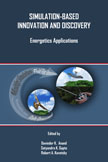Simulation-based Innovation and Discovery
Energetics Applications
D.K. Anand, S.K. Gupta, and R. Kavetsky
ISBN 978-0-9846274-2-4
CALCE EPSC Press, University of Maryland, College Park, MD, 2011
|
This book discusses nine representative and important applications in energetics research, development, and manufacturing. These include the use of classical molecular dynamics simulations to simulate the mechanochemical behavior of small oxide coated aluminum nanoparticles, a study focused on the design and implementation of an energetic material, an approach for simulation-based design of materials, an approach that uses small scale testing to predict full scale explosion effects, the development of new modeling capabilities for multiphase explosions containing a dispersed particle phase, a review of different models and approaches to study blast wave interactions with soft-tissue matter, a simulation-based approach to the design of drive mechanisms for flapping wing miniature air vehicles, and finally an investigation of the problem of task space synchronization and trajectory tracking for heterogeneous robots under dynamic uncertainties. |
|
|---|
The objective is to emphasize that simulation presents a fundamentally new way of discovering trends and insights that can be used by designers to create new products and policies associated with the development of advanced energetics capabilities, including the development of new production methods. Some experts hold the view that all the benefit of advancements in energetic materials has been obtained, and that the opportunity for new capabilities built on energetics is behind us. We hope to provide a cogent view that in fact a new era in energetics is upon us, wherein the use of modeling and simulation will enable entirely new capabilities to be developed from first principles that will enable exciting new advancements which were only ideas in the past.
Contact Ania Picard at picard@cecd.umd.edu to order a copy of this book.
Contents
CHAPTER 1 COMPUTATIONAL FOUNDATIONS FOR SIMULATION-BASED INNOVATION AND DISCOVERY IN ENERGETICS APPLICATIONS
1.1 Introduction
1.2 Simulation Driven Innovation and Discovery
1.3 Organization of Book
1.4 Conclusions
CHAPTER 2 MOLECULAR DYNAMICS SIMULATION OF ENERGETIC NANOPARTICLES
2.1 Introduction
2.2 Simulation Approach
2.3 Model Description
2.4 Results of Rapid Heating Simulations
2.5 Aluminum Cation Diffusion through the Oxide Shell
2.6 Induced Electric Field in Oxide Shell
2.7 Computed Stress in Oxide Shell
2.8 Laser Heating Simulations
2.9 Formation of Hollow Aluminum Oxide Shells
2.10 Conclusions
2.11 Acknowledgments
2.12 References
CHAPTER 3 TRIAMINOGUANIDINIUM 1-METHYL- NITRIMINOTETRAZOLATE – FROM SIMULATION TO EXISTENCE
3.1 Introduction
3.2 Prediction of Heat of Formation
3.3 Synthesis
3.4 Testing
3.5 Conclusions
3.6 Acknowledgments
3.7 References
CHAPTER 4 FUNCTIONALLY GRADED ENERGETIC MATERIALS: SIMULATION-BASED DESIGN OF MATERIALS
4.1 Benefits of FGEMs
4.2 Principles for Simulation-based Design of FGEMs
4.3 Inverse Design Procedure
4.4 Process Simulation
4.5 Simulation of Burning Rate Properties
4.6 Simulation of Ballistic Performance
4.7 Optimization of Composition Gradients
4.8 Combinatorial Development of New Energetic Formulations
4.9 References
CHAPTER 5 SMALL SCALE MODEL TESTING IN INVESTIGATIONS OF ENERGETIC MATERIALS – DYNAMIC EFFECTS LABORATORY
5.1 Underwater Cratering
5.2 Loading on Vehicles Due to Mines Detonating
5.3 Impulse Measurements
5.4 Pressures on Target Plates
5.5 Air Blast Pressure
5.6 Obstacle Movement Underwater
5.7 Summary
5.8 References
CHAPTER 6 DEVELOPMENT AND APPLICATION OF A COMPUTATIONAL MODEL FOR MULTIPHASE EXPLOSIONS
6.1 Motivations for Multiphase Explosion Models
6.2 Model Description
6.3 Simulation Results
6.4 Conclusion
6.5 Acknowledgments
6.6 References
CHAPTER 7 WAVE TRANSMISSION THROUGH SOFT-TISSUE MATTER
7.1 Introduction and Problem Description
7.2 Brain Injury Mechanisms
7.3 Different Efforts: Features and Findings
7.4 Nonlinear Visco-Elastic Model
7.5 Interaction of Acoustic Waves with Visco-Elastically Supported Mass
7.6 Brain Tissue Experimental Characterization
7.7 Wave Propagation in a Brain Fiber
7.8 Concluding Remarks
7.9 Acknowledgments
7.10 References
CHAPTER 8 SIMULATION-BASED SYNTHESIS OF PLANNING LOGIC FOR AUTONOMOUS UNMANNED SEA SURFACE VEHICLES
8.1 Introduction
8.2 Reactive Planning Logic Executor Architecture
8.3 Development of Physics-based Meta Model
8.4 Automated Generation of Blocking Decision Tree
8.5 USV Simulation Environment
8.6 Evaluation
8.7 Conclusions
8.8 Acknowledgments
8.9 References
CHAPTER 9 SIMULATION-BASED DESIGN OF DRIVE MECHANISM FOR FLAPPING WING MINIATURE AIR VEHICLES
9.1 Introduction
9.2 Simulation-based Design Framework
9.3 Case Study 1: Design of the Small Bird
9.4 Case Study 2: Design of the Jumbo Bird
9.5 Conclusions
9.6 Acknowledgments
9.7 References
CHAPTER 10 SEMI-AUTONOMOUS TASK SPACE MANIPULATION OF ROBOTIC MANIPULATORS
10.1 Introduction
10.2 Preliminaries
10.3 Semi-Autonomous Manipulation
10.4 Numerical Example
10.5 Experimental Results
10.6 Conclusions
10.7 References


